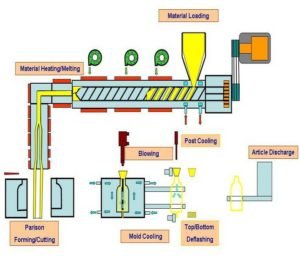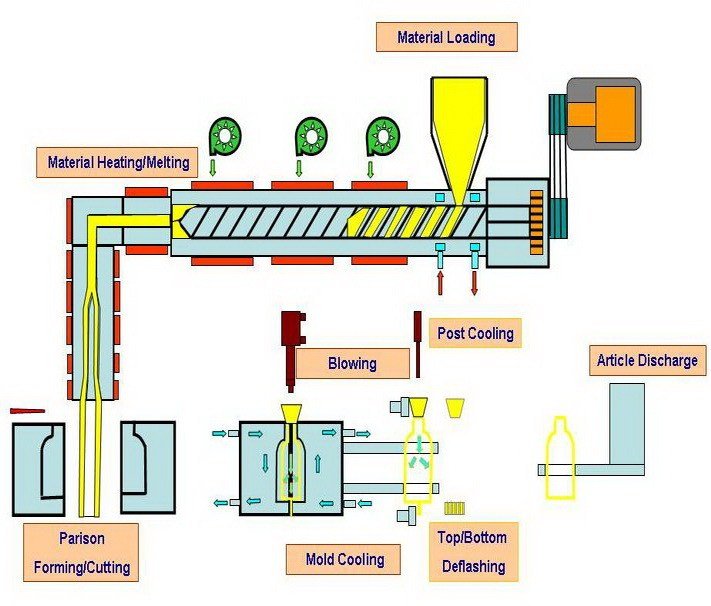TYPES OF MAINTENANCE & EXTRUSION BLOW MOLDING MAINTENANCE
There are two type of maintenance-
- Preventive Maintenance
- Breakdown/Corrective maintenance
Preventive Maintenance:
The activities, which are carried out to prevent the occurrence to failure are called preventive maintenance.
Preventive maintenance are also two types:
- Direct preventive maintenance
- Indirect preventive maintenance
Breakdown/Corrective maintenance:
The activities, which carried out after the occurrence of failure to correct the failures are known as corrective maintenance.

BLOW MOULD MAINTENANCE:
1) This procedure works best when the mold is at room temperature. This helps avoid burns to employees while doing the cleaning and reduces evaporation of the penetrating oil andbuffing compound.
2) Carefully blow off the mold surface. Wipe with a clean soft cloth, starting at the outside edge of the mold cavities and working outward.
3.) Using a brass scraper, remove any larger particles by gently scraping on the mold surface.
Note: Be careful using brass tools since they can become work hardened and become harder than steel.
4.) Use # 00 or finer steel wool and penetrating oil to clean the mold surface, being careful not to enter the cavity in order to prevent scratching it. Clean in the direction of the material’s flow through the mold, This should remove the majority of the residue. Carefully blow off the mold surface to prevent scratching, and wipe with a clean soft cloth.
5.) If there is still some staining or difficult to remove residue, a Balsam wood stick (soft or medium hardness) may be used. Make a paste using penetrating oil and buffing compound. Rub the Balsam wood stick in this paste and then rub the mold surface with it, being careful not to enter the cavity, in order to prevent scratching it. Carefully blow off the mold surface to prevent scratching and wipe with a clean soft cloth.
6.) A “felt bob” (soft or medium hardness) may be used in place of or after the Balsam wood stick. Make a paste using penetrating oil and buffing compound. Rub the Balsam wood stick in this paste and then rub the mold surface with it, being careful not to enter the cavity, in order to prevent scratching it.Carefully blow off the mold surface to prevent scratching and wipe with a clean soft cloth.
7.) After all cleaning is completed, carefully blow off the mold surface to prevent scratching and wipe with a clean soft cloth. The mold must be waxed and broke in before production parts are molded.
Mold Steels:
In high wear areas of the mold, the mold components can be machined from steel that is more wear resistant than standard mold steels like H-13 or S-7. Common steels used for this purpose are M3, D2 and Ferro tic. Because they are a hard steel grades and are more susceptible to cracking or breakage, they are typically only used in high wear areas.Protective Coatings
Many mold coatings have been developed to protect the mold by reducing its rate of wear.·
Chrome –
A thin layer of chrome is applied to the entire molding surface. This layer can be as thin as 0.025 mm (0.001″) or it can be as thick as 0.076 mm (0.003″). This not only protects the mold, but it aids in the release of the molded parts. The thicker layers of chrome are sometimes used to help correct an out of tolerance dimension.
·
Electroless Nickel –
This material is frequently used in molds processing thermoplastic materials, but in molds for processing thermoset materials it has some shortcomings. Nickel is soft and therefore tends to wear away rather quickly. It also does not have the same release properties as chrome, so the parts will not release from the tool as readily as if it were chrome plated. Additionally, some thermoset materials have fillers that will chemically react with nickel.
· Nitriting –
A nitrited surface is very hard and as a result it is more wear resistant than untreated steel. However, nitriting does not improve mold release properties of the tool.
· Titanium Nitriting –
A titanium nitrite surface is very hard which means it is more wear resistant than untreated steel. There are two methods of applying this coating to the mold.
One is referred to as the cold process and the second is referred to as the hot process.
Plenco’s understanding is that the recommended method for molds processing thermoset materials is the hot process. It is applied at about 900°F (482°C), but at this temperature the hardness of the mold can be reduced.
·
Other Coatings & Treatments –
Other surface treatments and coatings for molding surfaces are available, but it is important to have experience with these products before making comment on their use on tools for thermoset molding materials. When reliable information becomes available a statement about their suitability for use on thermoset molds will be added to this item.
Screw & Barrel:
The screw and barrel of the injection press should be checked at least annually for wear by measuring the ID of the barrel and OD of the screw flights. NOTE: The area of highest wear, as measured from the nozzle end of the screw and barrel assembly, will be at a distance equal to 3 times the diameter of the screw. When the combined wear of the screw and barrel exceeds 0.020″ (0.508 mm) total or 0.010″ (0.254 mm) per side, they should be rebuilt or replaced. A quick way to check the wear of the screw and barrel is as follows:
1. Retract the screw and barrel assembly from the fixed platen.
2. Purge an air shot but do not run the screw to plasticize the next shot.
3. Allow the material to cure in the barrel.
4. Remove the nozzle and end cap or head.
5. Carefully auger out and catch the cured material.
6. Cut the cured material in half and inspect the section as follows:
a) Measure the thickness of the flash over the screw flights.
b) Check the screw flights for wear.
c) Check the root of the screw for wear.
d) Check the screw for any type of damage.




